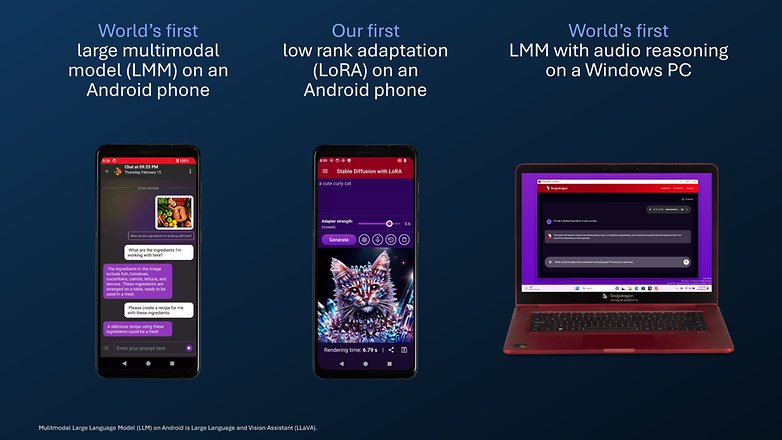AI Everywhere: Qualcomm Pushes AI Models to Devices of All Sizes


Read in other languages:
MWC is traditionally the place to see which are the latest (and sometimes future) trends in mobile technology, and nothing is hotter this season than artificial intelligence and especially large language models. Qualcomm has long offered hardware for processing AI tasks, but it is announcing an AI Hub to help developers showcase what they are capable of.
With its Hexagon series of DSPs (digital signal processor) and NPUs (neural processing unit), Qualcomm has been investing in AI hardware for many years. However, it faced the classic chicken-and-egg situation—just like competing SoC designers, by the way—that while the hardware is there, developers had no simple solution to tap into their power.

Qualcomm expects to change that with its new AI Hub announced in MWC 2024. The platform offers a library of more than 75 AI models certified and optimized to run on the many different Qualcomm platforms—not only mobile, but also VR/AR processors, automotive, PC, and more.
The list of supported models includes names such as Stable Diffusion, Llama, ControlNet, and applies not only to the current trend of generative AI but also speech recognition, image classification, object detection, image superscaling, and more.
According to Qualcomm, developers using its AI Engine SDK (software development kit) can easily integrate one of the available models by targeting its intended hardware platform, and the AI Hub will handle optimizing for better on-device performance, and efficiency.
If everything goes according to plan, the new AI Hub can fix the current fragmentation situation in which different brands can offer different levels of AI-powered features, with bigger companies such as Google and Samsung investing big teams to add AI to basically everything, while others have to manage their resources and time more carefully, resulting in fewer features, or worse, with features exclusive to their home markets where they can tap into powerful server processing.

Qualcomm also announced that flagship phones from three Chinese brands will leverage AI features in Snapdragon chips. Xiaomi will add image expansion capabilities, Honor will have video and calendar creation, while Oppo will include an image object eraser.
On the PC front, the upcoming Snapdragon X Elite was demonstrated creating an image with the Stable Diffusion plugin on the open-source GIMP image editor three times faster than the recently launched Intel Core Ultra 7 chip.
Wireless announcements
As in past editions of the MWC, Qualcomm announced updates to its FastConnect wireless processor and Snapdragon modem. The new FastConnect 7900 now integrates Ultra Wideband connectivity in addition to Wi-Fi and Bluetooth and also adds AI processing to improve transfer speeds and energy efficiency, similar to what the Snapdragon X70 5G modem brought in 2022.
Speaking of a Snapdragon modem, new for 2024 is the X80 model, with a second-generation AI processor for multi-antenna management, and support for even snappier downloads using 6 downlink aggregation (but still limited to 10 Gbps downloads). The Snapdragon X80 will also mark Qualcomm’s second attempt at satellite connectivity—after the canceled proprietary Snapdragon Satellite from 2023.

The Snapdragon X80 includes support for the NB-NTN (narrowband non-terrestrial) 5G standard. Like the previous Snapdragon Satellite initiative, compatible devices will initially support emergency messages, with a planned inclusion of short messages and maybe even data transmission in the future. When questioned by nextpit about which satellite operator/constellation the system will initially support, Nitin Dhiman, 5G Global Product Marketing director replied it will be Skylo, replacing the previous Iridium partnership.
The new FastConnect and Snapdragon cores are expected to arrive in devices launched later this year, They also should be integrated into the next generation of flagship Snapdragon SoCs, just in time for the 2025 season of smartphone releases.













